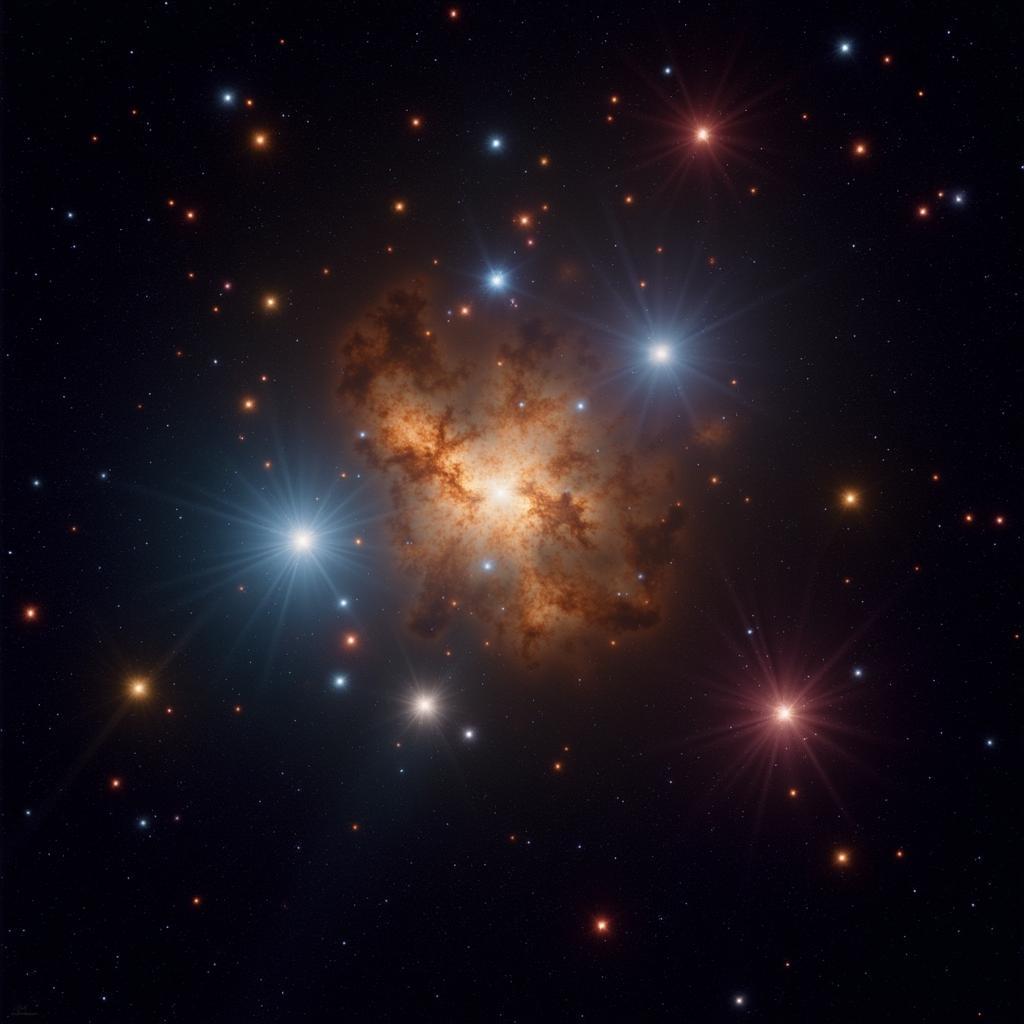We often associate colors with temperatures – red with hot and blue with cold. But when it comes to stars, it’s a bit more complicated than that. You might be surprised to learn that the coolest stars actually glow red, while the hottest ones appear blue. But why is that?
The Relationship Between Star Color and Temperature
A star’s color is directly related to its surface temperature. This might seem counterintuitive at first, but it all boils down to the physics of light and energy. Stars emit light across a spectrum of wavelengths, and the wavelength at which a star emits the most light determines its color.
Hotter stars emit more energy, and their peak wavelength falls within the blue and ultraviolet part of the spectrum. Conversely, cooler stars emit less energy, and their peak wavelength falls within the red and infrared part of the spectrum.
 Star Colors and Temperatures
Star Colors and Temperatures
Red Dwarfs: The Coolest Stars
So, what color star is the coolest? That title belongs to red dwarf stars. These stars are much smaller and cooler than our Sun, with surface temperatures below 3,500 Kelvin (about 5,840 degrees Fahrenheit). They emit most of their light in the red part of the spectrum, giving them their characteristic red hue.
 Red Dwarf Star
Red Dwarf Star
The Color Spectrum of Stars
Stars come in a beautiful array of colors, each representing a different temperature range:
- Blue Stars: The hottest stars, with surface temperatures exceeding 30,000 Kelvin.
- White Stars: Slightly cooler than blue stars, with temperatures between 7,500 and 10,000 Kelvin.
- Yellow Stars: Like our Sun, with surface temperatures around 6,000 Kelvin.
- Orange Stars: Cooler than our Sun, with temperatures ranging from 3,500 to 5,000 Kelvin.
- Red Stars: The coolest stars, with surface temperatures below 3,500 Kelvin.
It’s important to note that these are just general categories. The exact color of a star can vary depending on its size, age, and other factors.
Beyond Color: Other Factors Affecting a Star’s Appearance
While a star’s color provides insight into its temperature, other factors influence its overall appearance. These include:
- Distance: A star’s apparent brightness from Earth is affected by its distance from us. A closer star will appear brighter than a more distant star of the same intrinsic brightness.
- Interstellar Dust: Space is not a perfect vacuum, and interstellar dust can scatter and absorb starlight, making stars appear dimmer and redder than they actually are.
- Composition: While subtle, the chemical composition of a star can also slightly influence its color. For example, stars with higher concentrations of certain elements may exhibit subtle color variations.
Understanding the Universe Through Starlight
By studying the colors of stars, astronomers can glean valuable information about their temperature, size, age, and evolution. This knowledge helps us understand the life cycle of stars, the formation of galaxies, and the vastness of the universe we inhabit.
 Hubble Telescope Image of Stars
Hubble Telescope Image of Stars
Conclusion
So, the next time you gaze up at the night sky, remember that the seemingly simple colors of stars hold a wealth of information about these celestial objects. From the cool, red glow of red dwarfs to the intense blue light of massive stars, the universe is a breathtaking tapestry of color and light.
FAQs
1. Are there green stars?
While some stars might appear slightly greenish due to the way our eyes perceive light, there are no truly green stars. This is because stars emit light across a spectrum, and our eyes tend to blend the colors together.
2. What is the hottest star color?
The hottest stars appear blue, with surface temperatures exceeding 30,000 Kelvin.
3. How do we measure the temperature of stars?
Astronomers use a technique called spectroscopy to analyze the light emitted by stars and determine their temperatures.
4. Do all red stars have the same temperature?
No, even within the category of red stars, there is a range of temperatures. Red dwarfs are the coolest type of red star.
5. Where can I learn more about star colors and their significance?
For more information, you can visit our pages on what color is the coolest star and what factor affects the color of a star. You can also explore resources from NASA and other reputable astronomy organizations.
Need Help Choosing the Perfect Colors?
Whether you’re inspired by the cosmos or seeking to create a calming sanctuary in your home, Color Box Hà Nội is here to help. Contact us at 0373298888 or [email protected]. Our team of color experts is available 24/7 to guide you through our wide selection of paints and finishes, helping you transform your vision into reality. Visit our showroom at 86 Cầu Giấy, Hà Nội, and embark on a journey of color discovery!
